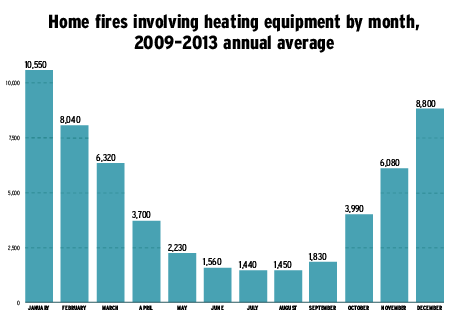
Utah’s average temperature for January 2017 is 5 degrees colder than the 2011-2016 average, according to U.S. Climate Data.
Cold weather tends to present new dangers, especially involving heating equipment, but the following tips can help students stay safe during the winter.
Fires
Half of home heating equipment fires are reported in December, January and February, according to the National Fire Protection Association.
“Smoke alarms are an absolute must,” said Provo Fire Department Capt. Dean York. “The big push that we always make is when you change your clocks to ‘spring forward’ or ‘fall back,’ that you also change the batteries in your smoke or carbon monoxide detectors to make sure those are functioning.”
York also emphasized clearing the snow from around fire hydrants so firefighters can find them in the case of a fire. Clearing sidewalks and using ice melt are also recommended to clear paths for firefighters.
Frozen pipes
York said another big problem firefighters deal with is frozen pipes.
“We end up getting busy when we have these cold spells,” York said. “People fail to open the cupboards under the sink to keep their pipes from freezing.”
York recommends setting thermostats no lower than 65 to 68 degrees to prevent this problem.
Frozen pipes seem to be a recurring problem for BYU students.
“Though it may seem like a good, energy-saving idea, do not turn your apartment heater all the way off before you go home for the holidays,” University Communications said in an email to students prior to Christmas break. “Turning the heat off could lead to frozen pipes and water damage. Setting it at 65 degrees is enough to help.”
BYU student Jesse Martinez returned home from Christmas break to find his home’s water pipes frozen.
“Our thermostat was too low,” Martinez said. “None of us thought ahead and didn’t anticipate Utah being that cold, so we didn’t do anything with the thermostat.”
Martinez said the frozen pipes were very inconvenient.
“I had just been in the car for 24 hours, and the first thing that I wanted to do was take a shower,” Martinez said. “We spent two or three days without water. I was bumming off showers from people in the ward and other friends of mine. I hope I never have to deal with it again.”
Carbon monoxide poisoning
A recent news release from Intermountain Healthcare emphasized the dangers of carbon monoxide poisoning.
“During each of the last two years, we’ve had nearly 30 patients come for hyperbaric oxygen therapy after CO (carbon monoxide) exposure in the winter months,” said Dr. Marc Robins in the news release. “We’d love to see that number decrease, but this winter we’ve already treated several significant CO exposure patients and could easily match our numbers from the recent past.”
Safety around carbon monoxide
- Remove the car from the garage to warm it up. Even with the garage door open, the exhaust can enter the house.
- Make sure vents for the furnace, dryer, stove and fireplace are clear of snow buildup during winter storms.
- Use generators outdoors, at least 25 feet away from windows, doors and vents.
- Burn charcoal outdoors, never indoors. Inspect the flue or vent system for your furnace, water heater, fireplaces and wood stoves each year.
- Ensure proper cross-ventilation if using gas-powered tools indoors and always have a visually alarmed CO detector within sight.
- Place carbon monoxide monitors on every level of your home. Replace them every five years.
Headaches, dizziness, nausea, weakness, stomach pain, blurry vision, drowsiness and confusion are symptoms of carbon monoxide poisoning. Anyone experiencing these symptoms should move outside to fresh air and seek medical help immediately.




